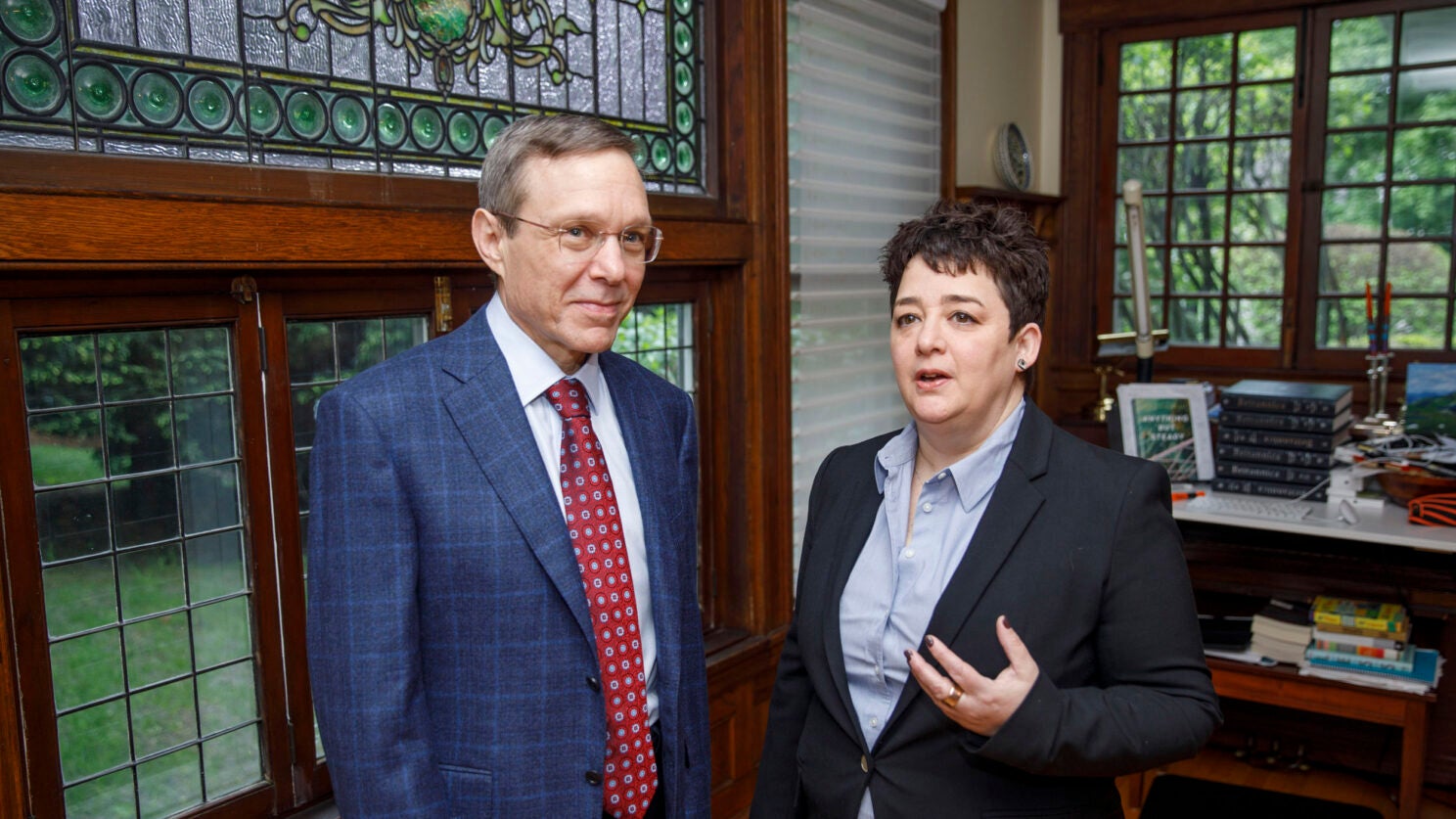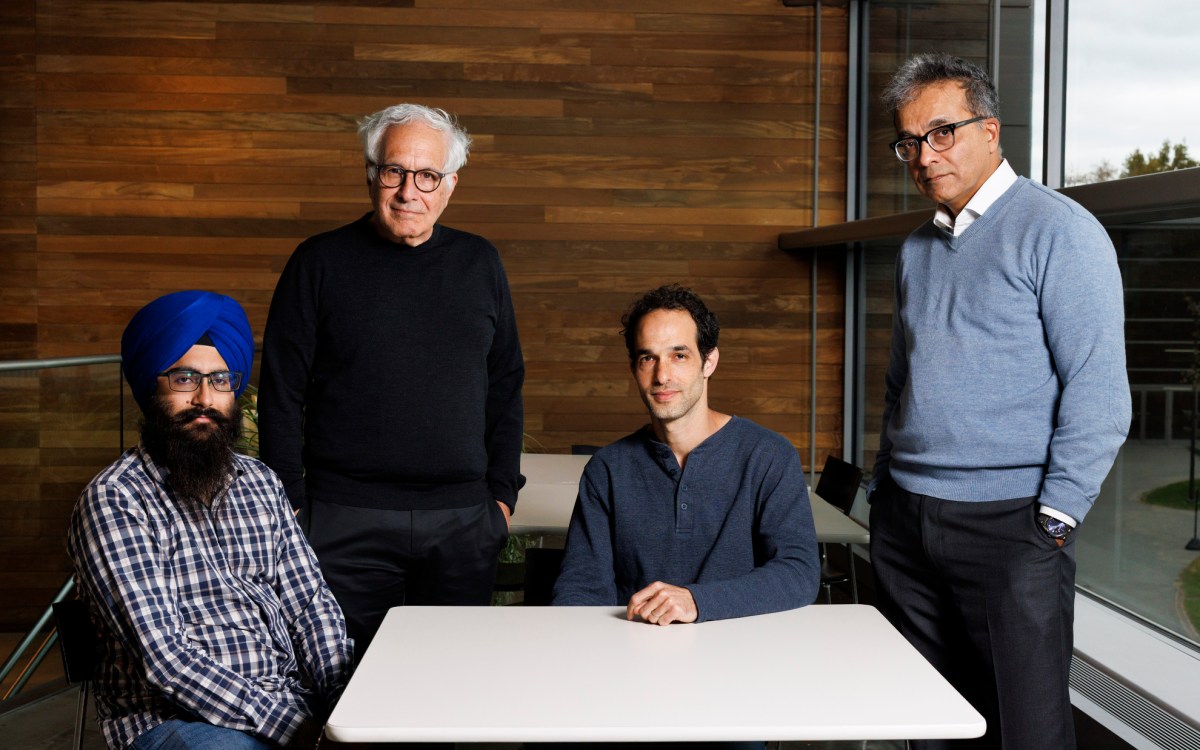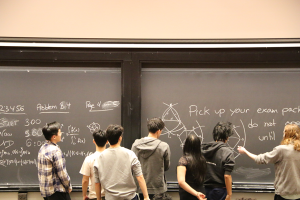
Avi Loeb (left) and Merav Opher used computer models to track the sun’s path back to a potential collision.
Kris Snibbe/Harvard Staff Photographer
More than a planetary fender-bender
New study finds Earth collided with dense interstellar cloud, possibly affecting life on planet
Call it the Milky Way mystery.
Evidence of a long-ago collision involving the Earth was there in the form of specific radioactive isotopes deposited across the Earth and Moon. There were, however, skeptics.
But now researchers have tracked the sun’s path through the Milky Way back to a crash 2 to 3 million years ago with a dense interstellar cloud. The event was so violent it appears to have collapsed the sun’s protective bubble around the solar system and possibly even affected life on Earth.
Merav Opher, a Boston University astronomy professor and director of BU’s SHIELD NASA DRIVE Center, made the discovery in work conducted during a 2021-22 fellowship at the Radcliffe Institute for Advanced Study and published recently in Nature Astronomy.
Her project explored whether the Earth might have come in contact with the interstellar medium outside of the heliosphere, the protective bubble around the solar system created by the sun’s magnetic field and the solar wind.
Though the Earth is often thought of as a planet circling a stationary star, the sun is constantly in motion. In fact, it travels through the galaxy at about 56,000 miles per hour — bringing with it the planets, asteroids, comets, and other bodies of the solar system.
Researchers believe that during those travels a collision may have happened between 2 million and 3 million years ago, and another around 7 million years ago. The evidence exists in the form of noticeable peaks in the deposition of two radioactive isotopes: iron 60 and plutonium 244. Both are very rare, created when massive stars explode in supernova. Those isotopes are thought to be more plentiful in the interstellar medium.
“It is everywhere, in the deep ocean, on the moon, on ice in Antarctica,” Opher said. “These papers describe a global phenomenon. Something happened. And iron 60 is not produced on Earth. So I knew that somehow this iron 60 got trapped in dust, and somehow, 2 to 3 million years ago, we had more dust delivered to us.”
For the interstellar medium (ISM) to be the source of the deposition spikes, however, something unusual must have happened, because today the ISM is nowhere near Earth. The heliosphere’s outer fringe — where the interstellar medium begins — is 11 billion miles away, well beyond the orbits of the outer planets.
Opher started her exploration of potential Earth-ISM contact by reviewing research on the sun’s galactic neighborhood, the “nearby” space out to 65 light-years away.
She initially found mostly empty space. But when she factored in the sun’s own movement, she realized that the solar system exits its interstellar neighborhood after about 1 million years.
And, as she looked farther down the path that the sun and its planets might have taken, her gaze settled on a string of dense clouds of interstellar dust and hydrogen atoms, called the Local Ribbon of Cold Clouds, 2 to 3 million years away as the sun flies.
“I got so excited,” Opher said. “This will collapse the heliosphere and then the Earth is in interstellar medium, collecting more dust, and that can explain this peak that I’ve seen in iron 60.”
Opher got in touch with Avi Loeb, the Frank B. Baird Jr. Professor of Science, who directs Harvard’s Institute for Theory and Computation, where Opher spent a sabbatical year from 2017 to 2018. The two used computer models to examine the movement of both the solar system and the interstellar dust clouds themselves, which are also in motion.
They tracked the sun’s path back to a potential collision with the densest cloud in the ribbon, called the Local Lynx of Cold Clouds, holding more than half of the ribbon’s total mass.
“We don’t often discuss the impact of astrophysics on Earth because the astronomical timescales are very long, and the human species emerged on Earth just a few million years ago,” Loeb said. “But a few million years ago there was the potential for us to be passing through a very dense cloud. We didn’t work out the biological implications, but it’s clear that if you shrink the heliosphere to within the orbit of the Earth around the sun, we are not protected anymore. It could have significant implications for life on Earth.”
For confirmation, they turned to Joshua Peek, an astronomer at the Space Telescope Science Institute, which runs the Webb and Hubble telescopes. Peek, who had published research on the Local Ribbon of Cold Clouds, cast a dubious eye on their work.
The relative movements of the bodies involved were complex, the statistics required to understand them advanced, and, he thought, the chances were vanishingly small that the sun passed through that Lynx cloud at the same time that the isotope depositions happened on Earth.
“It’s a pretty complicated thing to study,” Peek said. “So I thought, ‘I’m just not going to pay attention to this. This is some crackpot nonsense.’”
But Opher didn’t give up. She repeatedly reached out until Peek, on a pandemic-era trip to California, found himself with time on his hands. He had tested positive for COVID and, though he felt OK, was in self-imposed quarantine, far from home and the daily demands there.
So Peek decided to take a closer look at Opher’s idea. And the more he looked, the more plausible it became.
“It’ll be so easy,” Peek described his thinking. “I’ll just do a quick analysis — in one day — prove that this is impossible, and we can all move on with our lives. But after the very quick analysis, I thought, this is actually possible. I was just flabbergasted. I wrote back and said, ‘I thought I was proving you wrong, but it turned out I proved you right.’”
Interstellar space beyond the solar system is very heterogenous, Peek and Opher said.
In some places, like just outside the heliosphere, it is nearly a vacuum, averaging just 0.1 particles per cubic centimeter. By contrast, inside the heliosphere, near Earth, there are between three and 10 particles per cubic centimeter, 30 to 100 times denser. Inside a cold cloud, according to Peek’s prior research, particle density could reach 3,000 particles per cubic centimeter.
A collision with a cloud that dense would have collapsed the heliosphere to about 0.2 astronomical units, or about one-fifth of the distance between the Earth and the sun, Opher said. That would leave the Earth outside the sun’s protective influence as the solar system traversed the cloud.
Recent measurements by Voyager 1 and 2, the only crafts to have crossed from the heliosphere into the ISM, showed that the Earth would have likely experienced a spike in galactic cosmic radiation.
It also would have experienced a rain of particles — some interstellar dust, but mainly hydrogen atoms — through the atmosphere.
The particles would likely have changed the chemistry of Earth’s atmosphere, possibly affecting cloud formation, depleting ozone in the middle atmosphere, and cooling the climate.
Though outside the scope of their study, the three authors said the impact on life on Earth might have been substantial and recommended further exploration.
“Our work should trigger more studies into this question,” Loeb said. “It draws attention to our cosmic neighborhood as having potential influence on life on Earth. We usually tend to just look at it and enjoy it, but we are actually moving through interstellar space, and there could be risks along the way.”
Opher’s work is supported by the NASA DRIVE program.





